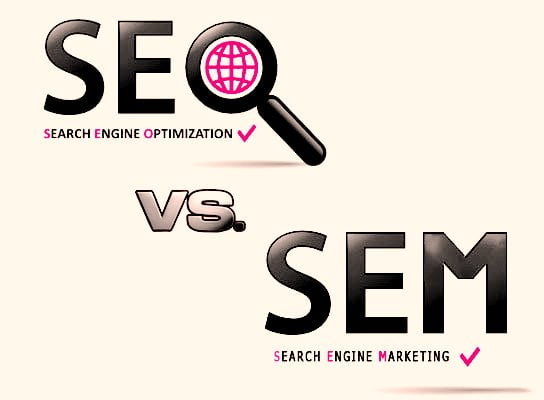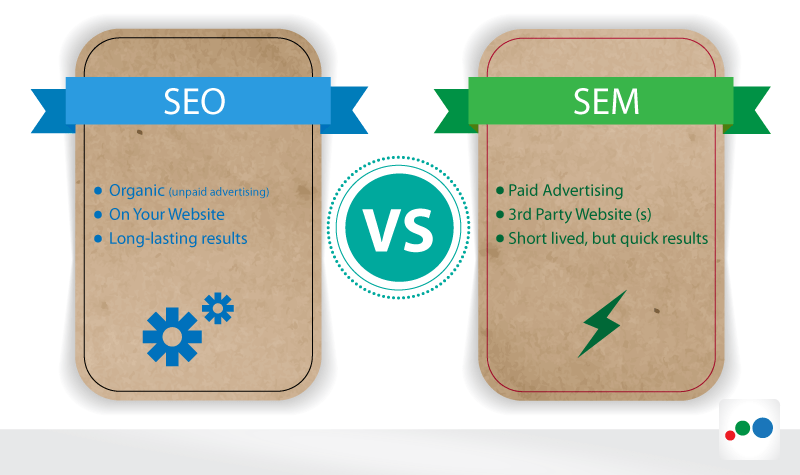SEO & SEM: Which Marketing Tactic is Better?

As the marketing world has evolved, so has the language that marketers use. In fact, we as marketers are probably confused with a lot of terms and often leave our clients confused. An example of this is Search Engine Optimization (SEO) and Search Engine Marketing (SEM), which are often used interchangeably without the clear understanding of how they’re related and how they’re different from each other.
SEO and SEM are easily quite confusing. Most experts who work in the search marketing know just enough on what both terms actually mean. It would be simple enough to assume that search engine optimization and search engine marketing are the same things since they both work on getting customers to your website. However, a closer look shows that they are actually two entirely different methods, each with their own set of disciplines and skills. Let’s examine the ways in which these two methods interact with each other in any marketing plan.

What is the main difference between SEO and SEM?
It ‘s very important to note that you should never use the terms SEO and SEM interchangeably because although they work the same, they are both entirely different.
The primary difference that you’ll see between SEO and SEM is that Search Engine Optimization is simply a part of the Search Engine Marketing process. However, both methods aim at improving visibility in search engines. SEO is used to optimize your website to get higher rankings in the search results while SEM goes beyond SEO and includes components such as Pay-Per-Click (PPC) and also Social Media Marketing (SMM). Generally, both involve other methods that can get you more search engine visitors.

What is SEO?
Search Engine Optimization is generally optimizing your website to get free traffic from the search engines. Having an optimized website can be easily found, and this increases the chances of a website to rank high in the Search Engine Results Page (SERP). A substantial part of SEO is generating relevant, high-quality content that your target audience will find useful. Over time, the results will increase the organic traffic to your website, providing more opportunities for inbound links and, more importantly, more sales.
The functions of SEO is continually evolving while keeping up with Google’s ever-changing algorithms. But one thing remains consistent: SEO is made up of 2 main parts, which is the on-page and off-page SEO.

On-page SEO consists of:
- Optimized pages including title tags, meta description, meta keywords and target keywords
- Simple and well-formatted page URLs with specific keywords
- Well-written and optimized page copy with well-incorporated target keywords
- Optimized page speed
Off-page SEO consists of:
- Increasing website traffic from social media sharing
- Link building to attract and acquire quality inbound links
- Drawing attention from social bookmarking sites
What is SEM?
Search engine marketing covers search engine optimization (SEO) and paid search, including PPC (pay-per-click). From the development of quality content with organic keywords to meeting Google AdWords guidelines, any web optimization traditionally fell under the SEM.
SEM is a marketing process with the purpose of getting more visibility in search engines either through paid traffic (Paid Search Advertising) or free traffic (SEO). Paid Search Advertising is mostly buying advertising space in the search engine results. So instead of waiting for your website to rank higher and get free traffic, you can pay to appear in front of the results page immediately.

SEM Activities
When it comes to SEM, there are several activities involved in creating and maintaining an effective paid search ad campaign. Here are several key activities needed for a successful SEM on any platform:
- Creating ad groups that consist of target keyword variations
- Launching ad campaigns with a particular audience in mind
- Monitoring metrics like clicks, impressions, click-through rates and average cost-per-click
- Writing relevant ad copy using specific keywords
- Setting an ad budget
So which one is better?
A lot of marketers debate whether one is better than the other. Many would argue that organic SEO is the best approach, but as you can see, a great SEM cannot succeed without the use of organic SEO.
SEO sets the basis for SEM through having a well-optimized content that visitors and customers will find helpful. Without any web pages and blog content optimized for the search, your SEM efforts will fail due to poor quality, and the visibility on the results page will be extremely difficult to achieve. On the other hand, if you are just starting to launch your first website, then you’re likely going to need some instant visibility in the search engines to build up your credibility. With SEM, you’d be able to achieve this. Although having organic SEO takes longer to show the results, in the end, it will be less costly, and you will build a search credibility that you might not establish with SEM alone.
When it comes to choosing the best marketing tactic, it is important to assess your specific needs, but make sure to completely understand the differences between the two and how you will maintain and support your efforts in the long run.

Recommendations




Leave A Comment